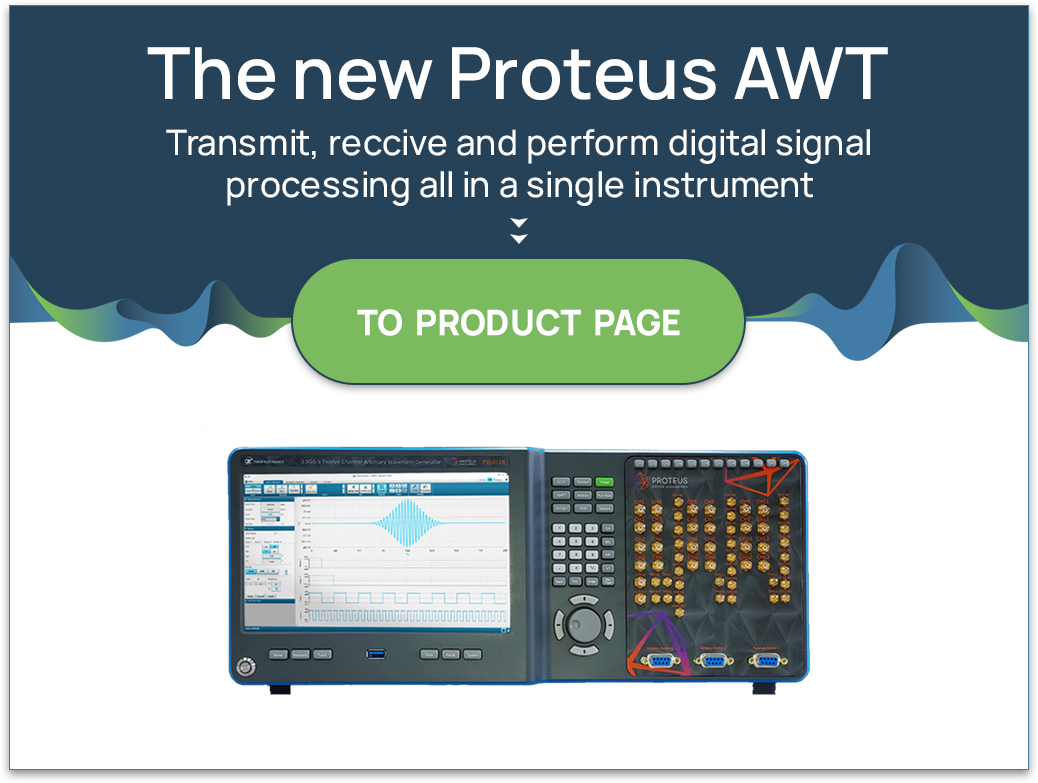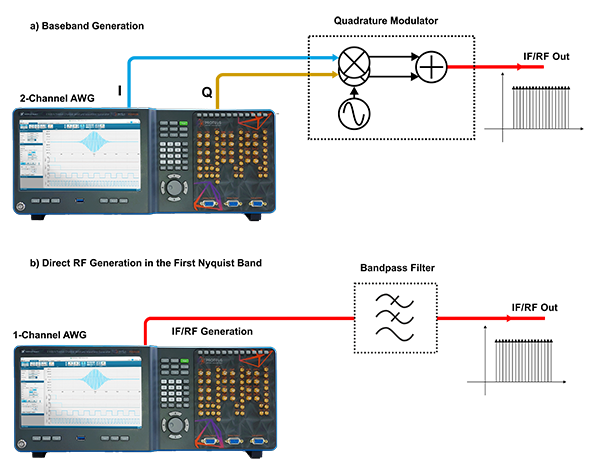

Multi-tone signals, to be useful, must be generated in a convenient and cost-effective way with sufficient quality to address the target application. One of the important issues to consider is the frequency band to be covered and the ratio between the central frequency and the bandwidth of the multi-tone signal. Another important consideration is the number of carriers to be generated and the required average power, peak power, and SFDR (Spurious Free Dynamic Range) necessary to match the application requirements. The type of test to be performed and if it requires controlling the relative phase of the tones may also influence the choice of multi-tone generation architecture.
Probably, the simplest way to generate a multi-tone signal is by combining multiple CW generators, one for each tone.

Figure 1.1 The most direct way to generate multi-tone signals is by using multiple CW generators and combining the outputs to a single signal. Absolute frequency, tone spacing, and amplitudes are easy to control this way. SFDR is as big as that of the individual CW generators. However, relative phase for the tones is not possible to control so its distribution will be like random, and PAPR will be high and it will grow with the number of tones. Other considerations are cost and size of the solution. Multi-channel analog RF/uW generators such as the Tabor Lucid LS12916R ( 16 channels up to 12 GHz in a very compact form factor), greatly reduce cost per tone and size.
All the outputs must be added together using an N-way passive combiner, so no additional distortion is introduced into the system. One of the advantages of this arrangement is that as all the generators are independent and a passive combiner is used, no IMD will be generated in the process and a very good SFDR can be reached. If the generators are not locked to the same reference, frequency spacing (and relative phase) between tones may change over time and lead to a variable spacing and PAPR. The Tabor Lucid series of multi-channel analog RF/mW generators is an example of a device especially adequate for multi-tone generation. These generators can support up to 16 independent channels internally locked to the same reference in a single 19” rackmount unit. Amplitude and frequency can be set independently for each channel, so any tone arrangement can be implemented, including multi-tone with none, one or more notches. This architecture has some drawbacks. First of all, the number of tones will be always limited by cost or implementation issues. Combining multiple channels into a single output using a low-IMD (passive) combiner is not free as the insertion loss grows with the number of signals being added together. CW generators can have a very large SFDR for frequency bands close to the tone frequency. However, harmonics can be significant, and they may show up within the band of interest when the ratio between the central frequency and the overall multi-tone bandwidth is low. Using this architecture should be restricted to the generation of limited BW (relative to the central frequency), a limited number of tones (a few tens), in applications where controlling the carrier phase distribution is not critical.
An alternative way to generate multi-tone signals is using a two-channel AWG to generate a baseband complex (I/Q), multi-tone signal that can be supplied to an additional I/Q modulator. While amplitude, spacing and phase of the carriers are controlled by the complex signal generated by the AWG, the central frequency may be set independently actuating on the LO (Local Oscillator) associated to the modulator. This strategy has two important limitations. First, the bandwidth of the multi-tone signal is limited by either the usable bandwidth of the AWG or the modulation bandwidth of the I/Q modulator. Second, any imbalance, differential delay or quadrature error will show up as images in the output signal, (see figure below) either affecting the amplitude and phase accuracy of the tones (if the images are located in the same frequencies as the valid tones), or as unwanted spurious tones (for notches or if the images are not located at the frequency of the valid tones).

Figure 1.2 Two-channel AWGs can create I/Q signal to generate a multi-tone signal at any frequency supported by an external IQ modulator (a). However, the system must be very carefully aligned as unwanted tones can show up as images (i.e. in the notch) even when non-linearities are small due to quadrature errors, imbalance of I/Q skew. Some high-performance AWGs, such as the Tabor Proteus series, can implement numerically IQ modulation and up-conversion (b). As modulation is produced numerically (including the generation of the quadrature L.O.), there are no modulator alignment issues.
A careful calibration and alignment procedure may be necessary in order to obtain a good-enough result. In many situations, differential linear predistortion of the I and Q components must be applied to reduce unwanted images to the required levels. The number of tones or controlling their phase is not a problem this time as tones are basically defined mathematically and spacing and relative phases can be precisely and consistently set. The Tabor Proteus family of AWGs are a good example of AWGs that can be used for this application. With up to 12 channels per desktop/benchtop unit and tens of channels in the PXIe modular form factor, they can feed multiple external I/Q modulators simultaneously so they can be combined to cover much higher bandwidths if necessary. The Lucid series multi-channel analog RF generator can be used as a LO source for any external I/Q modulator.
Finally, multi-tone signals can be generated directly using a one-channel AWG if there is sufficient analog bandwidth and sample rate to reach the maximum frequency.

Figure 1.3 AWGs can generate multi-tone signals by synthesizing the waveform mathematically and converting it to analog through their output DACs. AWGs can generate the quadrature baseband waveforms (I/Q) to feed an external quadrature modulator (a) or, if analog BW and sampling rate are sufficient, generate an IF or RF multi-tone signal directly (b). While requirements for a sampling rate may be much higher for direct generation, the usage of an external IQ modulator makes the alignment of the integrated generation system cumbersome.
AWGs can generate signals between DC and SR/2, and even beyond, if all the tones are located within any of the Nyquist zones. AWGs provide full control of the tone characteristics (number, frequency, phase, amplitude, notches) over an amazing bandwidth, and without any limitation regarding the absolute and relative location of the tones. Tone spacing can be very wide and very narrow and this is only limited by the size of the waveform memory. There are some limitations too. As all the tones are generated by the same device, any non-linearity in the device will show up as IMD components at the outputs. Even ideal DACs are inherently non-linear devices. Real-world DACs and wideband output stages will add additional non-linearities. However, all these limitations can be controlled if the signals are generated and corrected in the right way. AWGs are perfect for this as they can generate pre-distorted signals to compensate for any linear or non-linear imperfection. The Tabor Proteus P908x/P948x family of AWGs, with 9GSa/s sampling rate and a usable BW greater than 8GHz, is a good example of an ideal device for multi-tone signal generation.
For part 3 of the white paper - Generating Multi-tone Signals with AWG -Part 3
For more information contact [email protected]